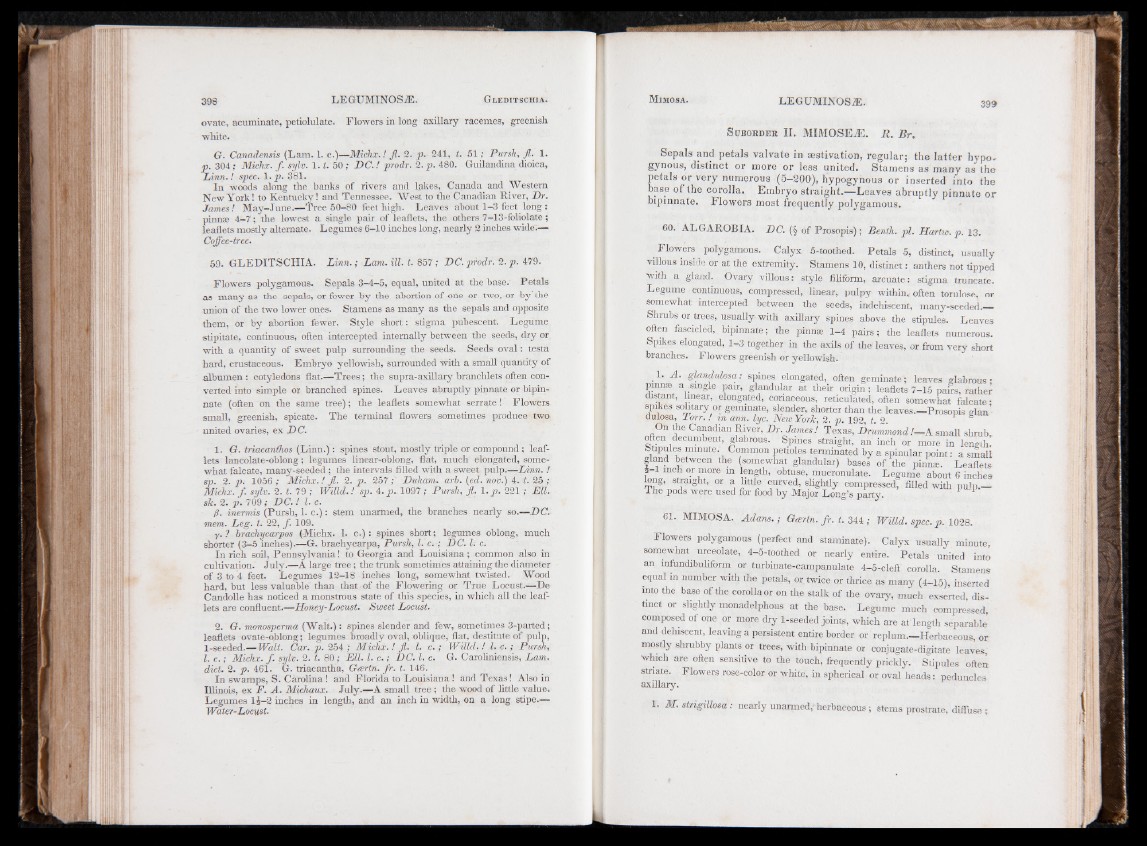
ovate, acuminate, petiolulate. Flowers in long axillary racemes, greenish
white.
G. Canadensis (Lam. 1. c.)—Michx.! Jl. 2. p. 241, t. 51; Pursh, Jl. 1.
p 304; Michx. f . sylv. 1 .t. 50 ; DC.! prodr. 2. p. 480. Guilandina dioica,
Lin n .! spec. 1. p. 381.
In woods along the banks of rivers and lakes, Canada and Western
New York ! to Kentucky! and Tennessee. West to the Canadian River, Dr.
James! May-June.—Tree 50-80 feet high. Leaves about 1-3 feet long :
pinnffi 4-7; the lowest a single pair of leaflets, the others 7-13-foliolate;
leaflets mostly alternate. Legumes 6-10 inches long, nearly 2 inches wide.—
Coffee-tree.
59. GLEDITSCHIA. Linn.; Lam. ill. t. 857; DC.prodr. 2 .p. 479.
Flowers polygamous. Sepals 3-4-5, equal, united at the base.' Petals
as many as the sepals, or fewer by the abortion of one or two, or by the
union of the two lower ones. Stamens as many as the sepals and opposite
them, or by abortion fewer. Style short: stigma pubescent. Legume
stipitate, continuous, often intercepted internally between the seeds, dry or
with a quantity of sweet pulp surrounding the seeds. Seeds ov a l: testa
hard, crustaceous. Embryo yellowish, surrounded with a small quantity of
albumen : cotyledons flat.—Trees; the supra-axillary branchlets often converted
into simple or branched spines. Leaves abruptly pinnate or bipin-
nate (often on the same tree); the Leaflets somewhat serrate ! Flowers
small, greenish, spicate. The terminal flowers sometimes produce two
united ovaries, ex DC.
1. G. triacanthos (Linn.): spines stout, mostly triple or compound ; leaflets
lancolate-oblong; legumes linear-oblong, hat, much elongated, somewhat
falcate, many-seeded ; the intervals filled with a sweet pulp.—Lin n .:f
sp. 2. p. 1056 ; Michx.! jl. 2. p. 257;" Duham. arh. (ed. nov.) 4. t. 25 ;
Michx. f . sylv. 2. t. 79 ; Willd.! sp. 4. p.-1097; Pursh, Jl. 1. p. 221 ; Ell.
sic. 2. p. 709; DC. ! l.c.
0. inermis (Pursh, 1. c .) : stem unarmed, the branches nearly so.—DC.
mem. Leg. t. 22, ƒ. 109.
y. ? brachycarpos (Michx. 1. c.) : spines short; legumes oblong, much
shorter (3-5 inches).—G. brachycarpa, Pursh, l. c, ; DC. 1: c.
In rich soil, Pennsylvania! to Georgia and Louisiana; common also in
cultivation. July.—A large tree; the trunk sometimes attaining the diameter
of 3 to 4 feet. Legumes 12-18 inches long, somewhat twisted. Wood
hard, but less valuable than that of the Flowering or True Locust.—De
Candolle has noticed a monstrous state of this species, in which all the leaflets
are confluent.—Honey-Locust. Sweet Locust.
2. G. monosperma (Walt.): spines slender and few, sometimes 3-parted;
leaflets ovate-oblong; legumes broadly oval, oblique, flat, destitute of pulp,
1-seeded.— Walt. Car. p. 254 ; Michx. ! jl. 1. c .; Willd,! l . c . ; Pursh,
l. c .; Michx. f . sylv. 2. t. 80 ; Ell. 1. c .; DC. 1. c. G. Caroliniensis, Lam.
diet. 2. p. 461. G. triacantha, Gcertn. fr. t. 146.
In swamps, S. Carolina! and Florida to Louisiana ! and Texas! Also in
Illinois, ex F. A. Michaux. July.—A small tree ; the wood of little value.
Legumes l i - 2 inches in length, and an inch in width, on a long stipe.—
Water-Locust.
S uborder II. MIMOSE.iE. R . Br.
Sepals and petals valvate in aestivation, regular; the latter hypo-
gynous, distinct or more or less united. Stamens as many as the
petals or very numerous (5 -2 0 0 ), hypogynous or inserted into the
base o f the corolla. Embryo straight.— Leaves abruptly pinnate or
bipinnate. Flowers most frequently polygamous.
60. ALGAROBIA. DC. (§ of Prosopis); Benth. pi. Hartw. p. 13.
Flowers polygamous. Calyx 5-toothed. Petals 5, distinct, usually
villous inside or at the extremity. Stamens 10, distinct: anthers not tipped
with a gland. Ovary villous: style filiform, arcuate: stigma truncate.
Legume continuous, compressed, linear, pulpy within, often torulose, or
somewhat intercepted- between, the seeds, indehiscent, many-seeded—
Shrubs or trees, usually-with axillary spines above the stipules. Leaves
often fascicled,, bipinnate; the pinna; 1-4 pairs; the leaflets numerous.
Spikes elongated, 1-3 together in the axils of the'leaves, or from very short
branches. Flowers greenish or yellowish.
. 3 g\andulosa; spines elongated, often gemmate; leaves glabrous •
pinna; a .single pair, glandular at their origin; leaflets 7-15 pairs, rather
distant, linear, elongated, coriaceous, reticulated, often somewhat falcate-
spikes solitary or geminate, slender, shorter than the leaves— Prosopis elan’
dulosa, Torr. ! m ann. lyc. New York, 2. p. 192, t. 2.
On the Canadian River, Dr. James! Texas, Drummond!—A small shrub,
often decumbent, glabrous. Spmes straight, an inch or more in length.
SUpuies minute. Common petioles terminated by a spinular point: a small
gland between the (somewhat glandular) bases of the pinna;. Leaflets
°-rm°le ™ v T 4 , obtu*e’ mueronulate. Legume about 6 inches
Tbf’-nnH gh ’ °r 1 slightly compressed, I he pods were used for food by Major Long’s party. filled with 1p ul1p—
61. MIMOSA. Adans. ; Gcertn. fr . t. 344 ; Willd. spec. p. 1028.
Flowers polygamous (perfect and staminate). Calyx usually minute
somewhat urceolate, 4-5-toothed or nearly entire. Petals united into
an mfundibuliform or turbinate-campanulate 4-5-cleft corolla. Stamens
equal in number with the petals, or. twice or thrice as many (4-15), inserted
into the base of the corolla or on the stalk of the ovary, much exserted, distinct
or slightly monadelphous at the base. Legume much compressed,
composed of one or more dry 1-seeded joints, which are at length separable
and dehiscent, leaving a persistent entire border or replum— Herbaceous, or
mostly shrubby plants or trees, with bipinnate or conjugate-digitate leaves,
which are often sensitive to the touch, frequently prickly. Stipules often
striate. Flowers rose-color or white, in spherical or oval heads: peduncles
axillary.
1. M. strigillosa: nearly unarmed,'herbaceous ; stems prostrate, diffuse;